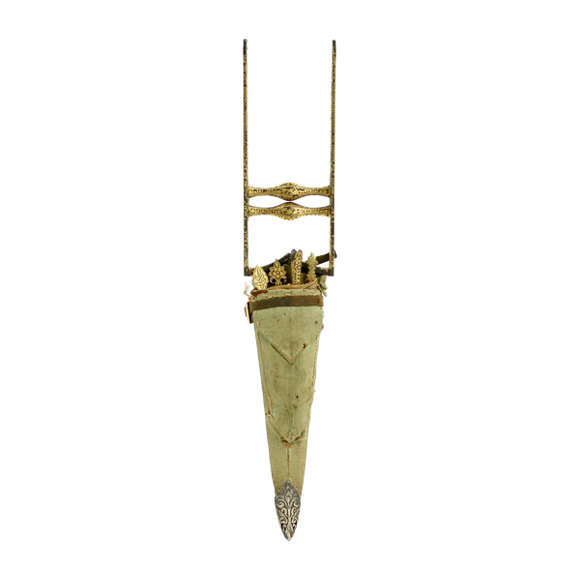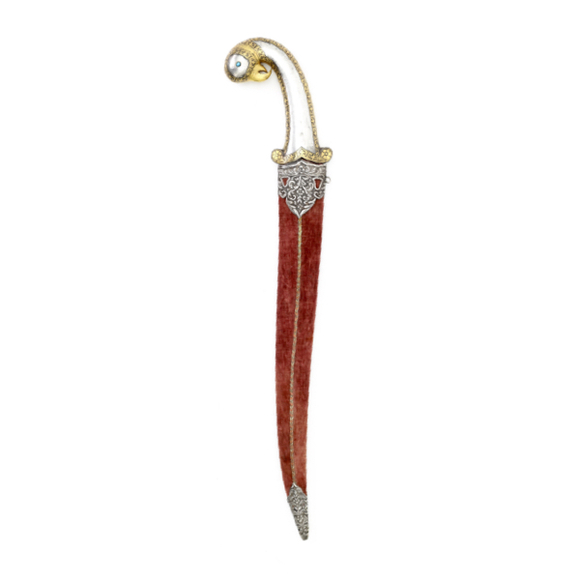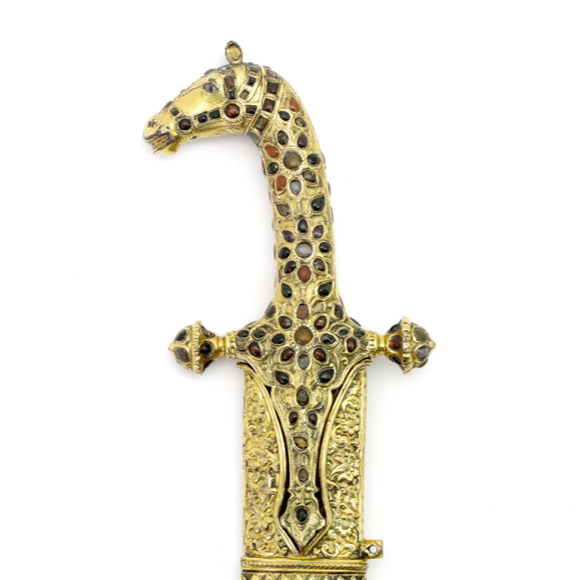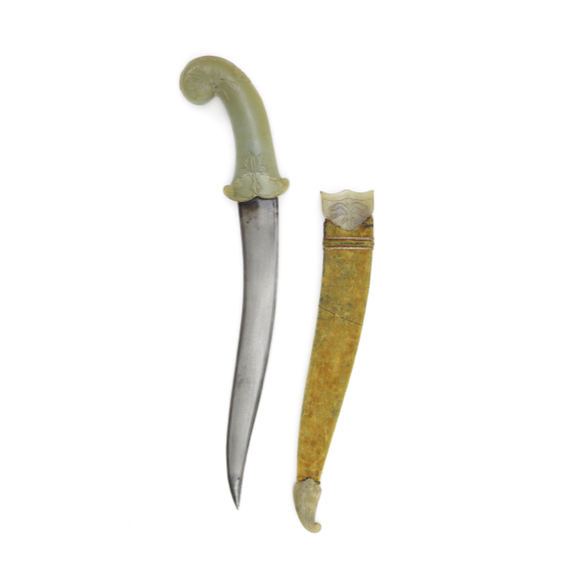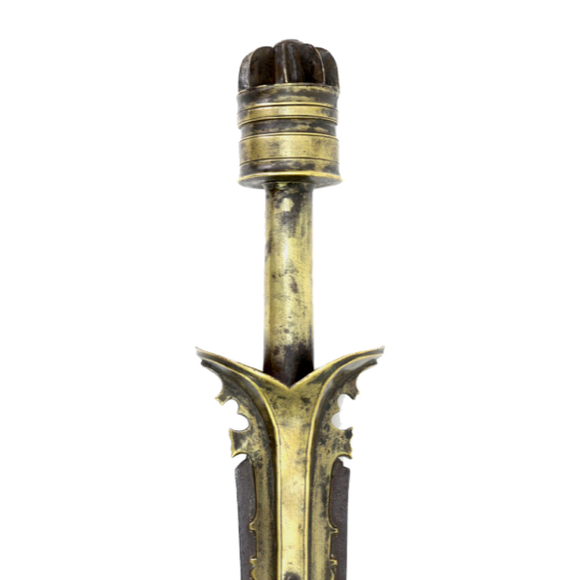With a fine wootz blade with a pronounced center ridge.

49 cm
Dome 5 cm
Width bosses 6 cm
2645 grams
Wootz steel, iron, silver, gold, silk velvet, copper, metallic thread, cotton thread, leather
Lahore, Sikh empire
Early 19th century
From a UK based private collector
Introduction
Steel shields were popular in India and Persia. Good ones would be decorated with chiseling and gold overlay. Some of the most prized among steel shields were those made of wootz. Such shields were called sīpar fouladi (सीपर फौलादि).
Hendley describes a number of steel shields in the contents of the Alwar armoury in 1888.1 Among which some sipar fouladi:

"Plate XXX. Sipar Fouladi. Shield. Steel, with raised floral pattern,which is damascened with gold. There are four bosses, each connected by raised open-work semi-circles with an outer crenated ring. The embroidered red velvet lining is attached to the edge of the shield with wire. The maker is unknown, but it was obtained from Hyderabad, in the Deccan, about fifty years ago, at a cost of Rs 1000. About Rs. 100 worth of gold were used in making it; and the steel, which came from Ispahan, is worth about Rs. 400. Diameter 21 inches."
A cost of Rs 1000 is very expensive. Let's compare it to some others in the same armory:

Plate XXXIII.
(1) Shield. Sipar-i-Shikargah. Hunting shield of steel, having a row of raised animals, which are fastened on with gilt pins. The edge is raised, and has its dentations pointing inwards. There are four bosses and a star-shaped centre. The ornament is damascened in gold. The shield was made at Sialkot, and cost R.s 125, of which the steel is worth Rs. 25, and the gold Rs. 60; the balance of Rs. 40 gives the value of the labour. Diameter, 14 inches.
(2) Shield. Sipar-i-Ganga-Jamni. Steel, inlaid with gold on a silver ground. Besides a crescent at the top, there are four bosses and a central ring. The pattern is composed of eight interlacing circles with chrysanthemum or daodi flowers. The rim is raised and toothed.
The shield was made at Sialkot.
Total cost, Rs. 65; gold and silver, Rs. 30; steel, Rs. 15; labour, Rs. 20.
Diameter, 13 inches.
(3) Shield. Sipar-i-Ganga-Jamni. Steel, inlaid with gold on silver. Rim dentated; outer border, scroll and floral pattern. Four raised bosses and crescent, all having perforated edges and without rims. The bosses are attached by quatre foil headed nails to the shield.
Made at Sialkot.
Total cost, Rs. 105; silver and gold, Rs. 50; steel, Rs. 15; labour, Rs. 40.
Diameter, 17 inches.
(4) Shield. Sipar-i-Fouladi. Steel inlaid with gold. There are two rings of ornament connected by inlaid bands. The four bosses are raised and have perforated rims.
Made at Lahore, and purchased for Maharaja Banni Singh.
Total cost, Rs.1000; steel, Rs. 400; gold, Rs. 100; labour, Rs. 500.
Diameter, 21½ inches.
(5) Shield. Sipar-i-Guldastardar. Steel inlaid with gold. Rim raised and toothed. There are four bosses, each at the meeting point of one of the parts of a raised quatre foil ornament. From the centre of each foil hangs a pear-shaped drop, having the point towards the centre of the shield. Made at Sialkot.
Total cost, Rs.125; gold, Rs.50; steel,Rs. 25; labour, Rs.50.
Diameter, 15 inches.
(6) Shield. Sipar-i-Chauddar. Steel inlaid with gold; raised rim; there are four bosses and a crescent.
Made at Sialkot.
Total cost, Rs.200; gold, Rs.100; steel, Rs.20; labour, Rs.80.
Diameter, 16 inches.
(7) Sipar-i-Ganga-Jamni. Steel inlaid with gold and silver. There are four bosses, separated by as many pear-shaped Kashmir figures.
Made at Sialkot.
Total cost, Rs. 150; gold and silver, Rs. 70; steel, Rs. 30; labour, Rs. 50. Fine work, but superficial.
Diameter, 20½ inches.
From the above we can see that "regular" steel shields cost Rs. 65, 105, 125, 200, 150 respectively, while both sipar fouladi are Rs. 1000 each. The wootz steel alone for one is already Rs. 400. We can also see that the labor significantly more expensive on the wootz shields, Rs. 40-80 for a regular steel shield and Rs. 500 for the wootz ones. This is probably due to the difficulty of working with wootz, and the fact only a few could do it well.
We must also factor in that wootz steel cannot be forged as hot as normal steel, or it will lose its pattern. When forging at lower temperatures, not only is it more arduous work, but the chance of the steel cracking is also higher. So for every one such shield finished, possibly one or more had failed in attempts.
Notes
1. Thomas Holbein Hendley; Ulwar and its Art treasures. W. Griggs & Sons, Ltd. London 1888. Plate XXX.
This example
A very large wootz shield with a lively and consistent pattern all over its surface. It has four bosses, also of wootz, with serrated borders, overlaid in gold. There are also remains of fine engraving in the center.
The rim is slightly upturned, reinforced with an iron strip. The strip is overlaid in a typical early northern taste that takes much inspiration from Persian art. We see birds, animals, both hunters and hunted, natural scenes, buildings, flowers and plants, and a pair of people riding elephants.
The inside lining is red silk velvet, with green velvet on the cushion, both decorated with fine embroidery using metallic wire. It has leather handle straps are held by gilt copper rings, connected to polyhedral nuts with flower-shaped washers.
There is a Hindi number 4 (४) carved into the face of the shield.
Condition
Wear to engravings and gold overlay. One grip strap snapped. Staining and losses to the inside lining. See photos.
Dating / attribution
There is a shield of similar form, with identical handle strap holders and very similar inside lining in the Toor collection of Sikh art.1 Instead of wootz this shield is entirely gold plated and has bosses set with gemstones. It bears an inscription on its outer rim:
"[May the] revered Immortal One Protect Hari Singh"
And a date Vikram samvat 1881, corresponding to 1824-25 A.D.
Hari Singh Nalwa (1791–1837) was first the personal bodyguard of Runjeet Singh and then commander-in-chief of the Sikh Khalsa Army. He may have gotten the shield after a difficult 6-month campaign where he lost 500 men and was himself almost killed.1
This shield is thought to have been made in Lahore. The Persian-inspired decor on ours could also point towards Lahore, which attracted many Persian armorers during the time of Maharajah Runjeet Singh (1780 – 27 June 1839). Many of the arms made there merge Persian and Indian stylistic elements.
Another comparable shield, 52.5 cm in diameter and with similar bosses and gold overlaid border is in the Alwar armory. Instead of wootz it has a patter called pechdar, consisting of swirling patterns achieved in pattern welding.2
Conclusion
A once very expensive wootz shield, probably from Lahore, in the Punjab. It most likely dates from the first half of the 19th century, the height of the Sikh empire in this area.
Notes
1. Davinder Toor; In Pursuit of Empire, treasures from the Toor collection of Sikh art. London, Kasi House, 2018. Pages 114-117.
2. Ibid.
3. Robert Elgood; Arms & Armour at the Jaipur court. Niyogi books, Delhi, 2015. Pages 164-165.

















The style typical of Kutch, the execution far above what is normally seen on work from that area.
Nice and complete with opaque green hilt and scabbard mounts.
An early fighting piece with strong reinforcing langet and broad, cobra shaped tip.

